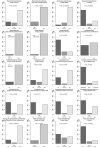Palliative Care in SMA Type 1: A Prospective Multicenter French Study Based on Parents' Reports
- PMID: 32133329
- PMCID: PMC7039815
- DOI: 10.3389/fped.2020.00004
Palliative Care in SMA Type 1: A Prospective Multicenter French Study Based on Parents' Reports
Abstract
Spinal muscular atrophy type 1 (SMA-1) is a severe neurodegenerative disorder, which in the absence of curative treatment, leads to death before 1 year of age in most cases. Caring for these short-lived and severely impaired infants requires palliative management. New drugs (nusinersen) have recently been developed that may modify SMA-1 natural history and thus raise ethical concerns about the appropriate level of care for patients. The national Hospital Clinical Research Program (PHRC) called "Assessment of clinical practices of palliative care in children with Spinal Muscular Atrophy Type 1 (SMA-1)" was a multicenter prospective study conducted in France between 2012 and 2016 to report palliative practices in SMA-1 in real life through prospective caregivers' reports about their infants' management. Thirty-nine patients were included in the prospective PHRC (17 centers). We also studied retrospective data regarding management of 43 other SMA-1 patients (18 centers) over the same period, including seven treated with nusinersen, in comparison with historical data from 222 patients previously published over two periods of 10 years (1989-2009). In the latest period studied, median age at diagnosis was 3 months [0.6-10.4]. Seventy-seven patients died at a median 6 months of age[1-27]: 32% at home and 8% in an intensive care unit. Eighty-five percent of patients received enteral nutrition, some through a gastrostomy (6%). Sixteen percent had a non-invasive ventilation (NIV). Seventy-seven percent received sedative treatment at the time of death. Over time, palliative management occurred more frequently at home with increased levels of technical supportive care (enteral nutrition, oxygenotherapy, and analgesic and sedative treatments). No statistical difference was found between the prospective and retrospective patients for the last period. However, significant differences were found between patients treated with nusinersen vs. those untreated. Our data confirm that palliative care is essential in management of SMA-1 patients and that parents are extensively involved in everyday patient care. Our data suggest that nusinersen treatment was accompanied by significantly more invasive supportive care, indicating that a re-examination of standard clinical practices should explicitly consider what treatment pathways are in infants' and caregivers' best interest. This study was registered on clinicaltrials.gov under the reference NCT01862042 (https://clinicaltrials.gov/ct2/show/study/NCT01862042?cond=SMA1&rank=8).
Keywords: SMA; caregivers; ethics; palliative care; standard of care.
Copyright © 2020 Hully, Barnerias, Chabalier, Le Guen, Germa, Deladriere, Vanhulle, Cuisset, Chabrol, Cances, Vuillerot, Espil, Mayer, Nougues, Sabouraud, Lefranc, Laugel, Rivier, Louvier, Durigneux, Napuri, Sarret, Renouil, Masurel, Viallard and Desguerre.
Figures
References
Associated data
LinkOut - more resources
Full Text Sources
Medical




